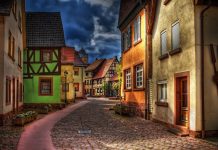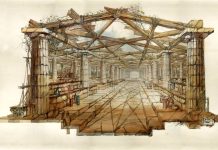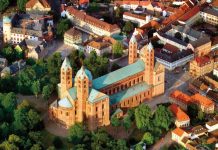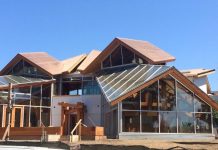The Chapel of San Teodoro, together with the new sacristy, was constructed immediately behind San Marco from 1486 to 1493, hemmed in by a canal, the Palazzo Ducale and the Palazzo Patriarcale. Battered by interventions over the centuries, its original design – from its foundations to the lost external dome – is only now beginning to be understood thanks to the discovery of new documents, allowing us to appreciate its architectural and historical importance.
The sacristy is both a service space and an official reception room, and rich mosaics cover the low vault with its exceptional span. The adjacent San Teodoro is about half the size, but despite its small dimensions it has considerable impact. Built as the private chapel of the canons of the Basilica, it was later used as a tribunal of the Inquisition. It is a single room consisting of a squared, central space now covered by a cross vault – originally a dome – with two lateral barrel vaults in which four niches are inserted.
Three further radial niches enclose the space of the apse, creating a peculiar play of frames and corners. The proportions and rhythm give harmony to the space, while the lack of decoration creates a notion of refined abstraction. An interpretative reading of San Teodoro suggests an elegant and conscious rationalization of a traditional space following humanistic and geometric precepts, or, to use Manfredo Tafuri’s description of the neo-Byzantine style, ‘Byzantine dispositio, Albertian inventin’.
The exterior has two facades, one overlooking an inner courtyard, the other rising above the canal and connecting the chapel and sacristy with imposing stone cladding. The design of the canal facade aims for an extreme purity of line: as John McAndrew has noted, its form was ‘more severe than any important work yet built in Early Renaissance Venice’. The other facade of the building, where the entrance is located, is also simple in design and its only decorative element is the main portal in Istrian stone, finely carved with floral friezes.
But – as we shall see – its original appearance was not so austere, and the facade of the courtyard was an important aspect of the building. The complex as a whole, including the chapel’s wood-and-lead dome, indicates that this was an expensive and ambitious project, one that the Procuratoria commissioned for one of the most exclusive sites in the vicinity of the basilica.
The ‘architects’
In late-fifteenth century Venice, the Renaissance idea of architecture was not yet clearly defined, nor was the role of the architect. Recent studies demonstrate that preeminent names such as Lombardo or Codussi were more similar to a stonemason than to an intellectual architect like Alberti, that a sculptor could also be a yard director, and that entire equipes of different artists – painter, sculptors – moved together from one building yard to another.
By removing the ‘problem’ of attribution and its accompanying rhetoric, new avenues of research regarding buildings and their executors may open up. The execution of San Teodoro was entrusted in its entirety to the proto of the Procurators of San Marco, Giorgio Spavento, described as ‘the least known of the paramount masters of architecture in early Renaissance Venice’.
Despite the fact that his name appears in connection with the most important building projects of his time – from models for the Rialto Bridge and the bell tower of San Marco, to the Fondaco dei Tedeschi and the church of San Salvador – we have little reliable information on his activities. The Sacristy was his first project and the only building that he ever supervised through to its completion. He was constantly on site and oversaw every aspect of this work. Yet, there is no reference in related documents to models or drawings by him, and the only mention of the project occurs when Spavento gives the stonemasons ‘forme et mexure’ (shapes and measures) for the chapel portal.
As a result, his skills as an architect are in question. His formation and network of relationships are unknown. In historical scholarship, Spavento’s work has been consistently linked to that of Mauro Codussi, one of the most important protagonists of the Venetian early Renaissance. And yet, it would seem that Codussi and Spavento could not be more different: on the one hand, there is the figure of Codussi, who ‘appeared in Venice as suddenly and brilliantly as a comet’ – an innovator, an intellectual architect who introduced the ‘Albertian avant-garde’ to the lagoon; on the other, there is Giorgio Spavento, the shadowy proto dei Procurator!, part-engineer, part-administrator, possibly an architect – a singular figure who embedded himself in the ‘culture’ of construction sites and whose design skills were hidden by his institutional role.
This categorization is, however, completely outdated. A more profound insight is required if we are to penetrate the real system of architectural production in Renaissance Venice. We must turn to primary sources that reveal entirely different narratives from those presented in the art-historical literature to date. Our focus must be less on the celebrated names of architectural history and more on the often-anonymous workers. In fact, a reading of the construction documents related to the sacristy and to San Teodoro reveals that Codussi’s only role was as the supplier of Istrian stone.
This job was not considered in any way demeaning, for it was not unusual for the proto to be involved entrepreneurially in some way in the transportation of stone in addition to his other duties. In Venice at the end of the fifteenth century, trade with Istria was organized particularly when the construction of a building of great importance was involved: the capomaistro (master mason) of the building yard went to Istria to choose the best material in person, accompanied by a team of trusted quarryment and transporters, all of whom were paid by the client.
Often the masters who went further afield returned with boats full of large quantities of stone to be sold throughout Venice. It was a commercial business much more financially rewarding than purely artistic work. All of this sheds light on the type of collaboration that could bind one construction site to another or one master to another. Already in 1486, Codussi’s name appears in connection with some minor work in San Marco, mainly as a supplier of stone.
The bills in the Procurators’ ledger make it clear that the commission was for Spavento’s site and that Codussi was directing the entire operation, from the quarrying to the transportation. A whole team of people worked for him – quarrymen, masons, sailors – their names constantly recurring, and not just in connection with the sacristy and San Teodoro. It is very important to highlight the fact that in these years Codussi was involved in the construction of both the bell tower of San Pietro di Castello (1482-90) and the prestigious convent and church of San Zaccaria (about 1483-91).
For both fabriche (construction sites], the contract stipulated that he went in person to Istria in order to select the best stone. In fact, from 1483 to 1488, there are records of him and his brother Bernardo making about two shipments a year to Venice. From this information, it is clear that Codussi and Spavento collaborated; a link existed between their respective fabriche, even if it was only economic and commercial in nature. But there is more.
EARLY MODERN
The stonemasons In fact, from 1485 to 1487, the stonework was entrusted to Giacomo Lanza. Lanza was not just any master, for, like Giorgio Spavento, he was paid directly by the Procurators as official master of the stonemasons. At the beginning, Lanza was not only the supervisor, but also the executor. However, from 1487 to 1488 a significant change occurred, and it is this detail that allows us to infer just how Codussi and Spavento exchanged knowledge and how their building sites were connected.
From 1488 – but only in the construction of the sacristy – Lanza was replaced by two new master stonemasons named Corradino and Domenico, a father and son team who began to supply Spavento’s site with stone. But Corradino and Domenico were involved not only in travelling back and forth across the Adriatic Sea, but also in the project itself. The remaining stone cladding of the canal facade is their work, as is the internal and external stonework. Their names were certainly known in Venice, for they were close collaborators of Mauro Codussi.
Corradino worked on all of Codussi’s major projects of the time, appearing in the documents among the artisans working at San Michele in Isola, the bell tower of San Pietro, the Scuola di San Marco and the Scuola di San Zaccaria. Pietro Paoletti says that ‘he was skilled only as squadratore’ (squarer), but he also records Corradino’s constant participation resulting from his role as supervisor. Domenico, his son, came directly from the San Zaccaria site.
After his father’s death in 1489, he continued the work in San Teodoro. This movement of workers is extremely significant. It was certainly profitable for them from an economic point of view: but it is especially interesting to see that from the moment the decision was taken by the Procurators to supply the stone for Spavento’s project directly from Istria, it was the two men trusted by Codussi, Corradino and his son Domenico, who took charge. And with them, from 1489, went all the taiapiera (stonemasons) who were working on the sacristy and in San Teodoro, as well as the team of Istrian quarrymen, even the transporters, all of whom were Codussi’s men.
The relationship between Mauro Codussi and Giorgio Spavento was such a connection, a bond that was not created in the privacy of a study or an erudite circle, but rather one that was deepened by the intellectual and practical skills of these craftsmen. It is easy to imagine that when Spavento sought advice from Codussi regarding the facade that flanks the canal and runs alongside the Ducal Palace – a complex and institutional setting – Codussi didn’t send him a drawing or a design, but rather his own trusted men.
The forms and style of the facade are close to some of Codussi’s work, suggesting that the facade’s design represents the result of the two architects sharing their experimentation with the compositional language of buildings. But it is characteristic that this sharing of ideas was not conceptual; rather, it occurred ‘physically’, in the handiwork of actual people. The other maistri The same inextricable connection between sites and the exchange of personnel can also be perceived in the payments for the main door of the chapel, as well as in those pertaining to the decorative details of the project. Here it is noteworthy that there is no difference between the sculptural elements inside and outside the building.
We have noted above that Domenico was not a sculptor as such, but a skilful squadratore, who made all of the stone parts of the building, as demonstrated by the long list of tasks for which he was paid on the closure of the site: stone plates for facades, window frames, decorations for the interior were all included in the same payment. Instead, the more important differences exist in payments for sculpture: for the main portal Spavento provided the measures, and two different stonemasons were called to realize the different parts. The capitals, frieze and the volto (arch-gable) were made by Matteo da Valle, whereas the pillars were carved by a stonemason called Sebastiano.
It is important here to identify these masters as part of the history of Venetian architecture and sculpture, not only for the purpose of attribution, but because, as we shall see, through these names it is possible to better understand the artistic scene of the late-fifteenth century. Matteo da Valle was a stonemason of Istrian origin; he may be related to the workshop of Giovanni Buora, since his name appears in the building yard in San Giorgio Maggiore, as his first assistant in 1495. In 1504, da Valle was commissioned to make the high altar of the Scuola di Sant’Grsola, and in the same year was employed in the construction of the new monumental basilica of Santa Giustina in Padua, where he was first appointed as master builder, and then – on account of various vicissitudes on the fabrica – as proto until his death in 1532.
The consonance between the designs for Santa Giustina and San Salvador has usually been explained by scholars as being related to their previous collaboration in St Theodore. But the interesting point is that da Valle worked for Codussi too: according to Paoletti, da Valle was among the masons who worked on the facade of San Zaccaria between 1485 and 1486, particularly on the pillars, pilasters, entablature, and the three curvilinear gables of the upper facade. It confirms once again the strong link between sites and masters, placing Matteo da Valle in a larger frame of reference. The name of the other stonemason who carved the portal pillars in fuxaru- olli and foiami (tapered pearl and vegetal decoration), maistro Sebastiano, is even more difficult to document because he can so easily be confused with many stonemasons of the same name working in Venice at that time.
Some studies however identify him with the artisan who carved the stone frame for the altarpiece by Cima da Conegliano in the church of San Giovanni in Bragora around 1495. From the documents in the parish archive it emerges that around the stone altarpiece there was another framed fresco, painted by a Tommaso de Zorzi pintor (painter). The subject of this fresco, lost in the seventeenth century after the altar transformation, is unknown, but probably it was similar to the paintings still visible all around the church; that is, a red frieze with floral decoration in white and black.
These decorations were discovered and restored in 1925, following the original traces. However, comparing information from the archives with the surviving traces of frescoes, I have been able to identify Tommaso de Zorzi as the artist who painted the inner courtyard facade of San Teodoro in 1492. This is confirmed by some residual traces of old plaster with polychrome decoration visible to the naked eye: the largest fragment is hidden under the arch of the staircase leading to the upper sacristy. It is composed of a series of six cassettoni with a shield or patera in the inner circle.
Around the doorway and windows are still visible red backgrounds, straight black lines and a few hints of white painted decoration. Literary sources are not helpful for understanding external pictorial decoration in Early Renaissance Venice: however, as the paintings by Vittore Carpaccio and Bellini show, this was the most common and representative pattern used in frescoed decorations in Venice. But the material data confirms the words recorded in the ledger, and comparisons with other examples suggest that the fresco on the facade of San Teodoro was probably very similar to that of San Giovanni in Bragora.
Tommaso worked with Sebastiano on two occasions at two different building yards, executing painting and sculpture for both interiors and exteriors of Venetian buildings. The pair constituted a sort of team, which moved around the city under the direction of other masters. What is more, Tommaso himself frescoed another facade by Spavento, that of Santi Filippo e Giacomo, whose main door was carved by Domenico Lanza, the brother of Giacomo, who also made the beautiful portal of the church of the Ospedale del Gesii in Castello, a project also directed by Spavento.
All of these examples – little traces – reveal that the culture ‘before’ architects in which Codussi, Spavento and others operated was mainly based on practice, but it was also a fertile ground in which the new ideas coming from Florence, Urbino and Rome were able to take root and grow. These architectural projects relied on an intricate nexus of collaborations, a continuous exchange of expertise, without barriers between disciplines: a sort of connective tissue that created the common ground of Early Renaissance art and architecture in Venice.




















